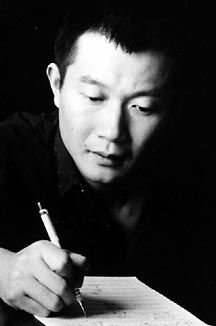 Tan Dun is without doubt the best known Chinese composer in the West.
His popularity seems to owe as much to his participation in political and
media-based projects as to his talent, the best example being his Symphony
1997,
written for the handing over of Hong Kong to China in
1997.
Tan Dun is without doubt the best known Chinese composer in the West.
His popularity seems to owe as much to his participation in political and
media-based projects as to his talent, the best example being his Symphony
1997,
written for the handing over of Hong Kong to China in
1997.
Tan Dun's works from the 1980s
have fused with the spirit of a counter-culture like those of Toru Takemitsu or
John Cage, which question the dominance of Western music. In the 1980s, Tan
Dun's composing changed considerably and his style was to have a great influence
on other Chinese composers.
Tan Dun would allude to all
sorts of other works, even falsifying some of them. The most important change in
his writing was that he brought together, in a single work, stylistic and
cultural elements from highly diverse sources. In many of his subsequent
compositions, he developed a more stripped-down style, less complex,
simpler.
His opera Marco Polo, written between 1991 and 1995 and given its
world premiere in 1996, is a very good example of a composing style that
resembles a sound mosaic more than anything else. He describes this work as "an
opera within an opera." It incorporates musical themes borrowed from various
cultures or other works, including Mahler's Song of the Earth and Shakespearean passages recited in the style of the Peking opera.
Tan Dun's Symphony 1997 is also filled with the most disparate musical
references. Among others, you can hear the famous Chinese bells made over 2,400
years ago that produce two different sounds, passages from Beethoven's Ninth
Symphony, a melody from a Hong Kong street opera, and a quote from his
concerto for cello. Strange to say, he cites the Chinese air "Molihua" (jasmine
flower) from Puccini's Turandot rather than the original, traditional melody.
Tan Dun cites, reproduces, and imitates other music in order to give these
melodies a fresh context. He offers his audience musical mosaics of his own
expression, which could be heard very clearly in his score for the film,
Crouching Tiger, Hidden Dragon.
* This article is a summary of the article by Christian Utz, "A Marco Polo
(re-) constructed by the West, Intercultural Aspects in Tan Dun's Compositional
Approach," appearing in World New Music Magazine, # 12, pp.
1–7.


